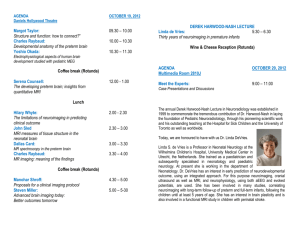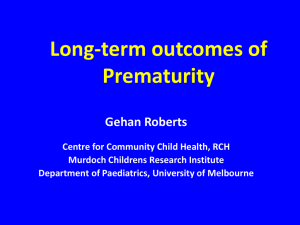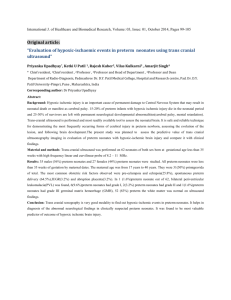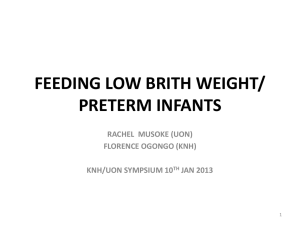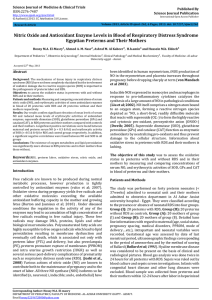Preterm Birth - Oncourse
advertisement
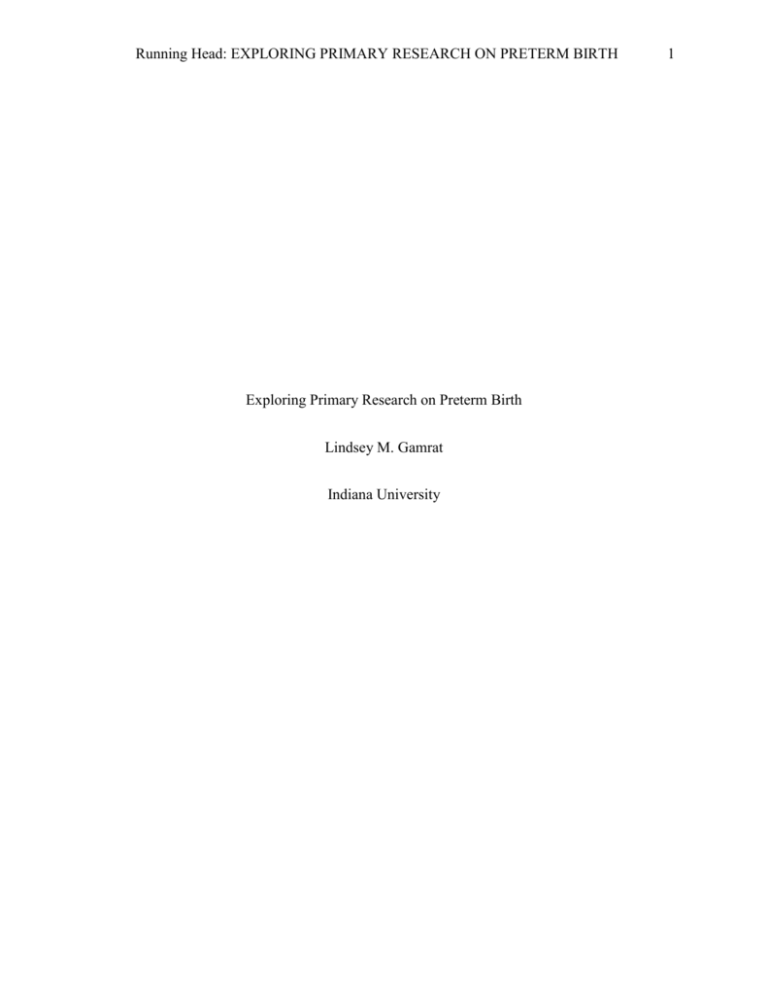
Running Head: EXPLORING PRIMARY RESEARCH ON PRETERM BIRTH Exploring Primary Research on Preterm Birth Lindsey M. Gamrat Indiana University 1 EXPLORING PRIMARY RESEARCH ON PRETERM BIRTH 2 The ability to locate scholarly research articles relating to a specific topic is a vital skill to have for a BSN student. Having a bachelor’s of science in nursing gives a nurse more education on abstract ideas, such as ethics, as well as knowledge and the ability to research. Research is also a key component for a nurse who would like to continue his or her education to attain a masters or doctorate, as many students in the Indiana University School of Nursing have the desire to do. At the start of her nursing school career, the author was required to select a topic that she would like to conduct evidence based research on. This topic would follow her for the rest of her educational career, so it was important that she selected a topic that deeply interested her. The author has always had an interest in pregnancy and birth, so she knew she wanted to select something related to this. When the author was 10 years old, she had a baby sister born prematurely who had to spend time in a neonatal intensive care unit. The author was very fascinated by the miracle of watching her sister grow from a tiny preemie who could not breathe on her own into a healthy baby girl. Ever since, the author has been very passionate about premature birth and felt that helping other babies like her sister was her calling in life. She is an officer for the IU Collegiate Council for March of Dimes and hopes to one day work in a NICU. This interest in the field drove her to select a topic where she could begin learning and researching preterm birth. The author selected the topic of “antepartum” in the labor and delivery category because this period “before birth” includes preterm deliveries. The author feels that her topic is an area that definitely needs a lot of research. One out of every eight babies in the United States is born too soon. Every year, 13 million babies worldwide are born prematurely (March of Dimes, 2011). This is a staggering percentage and for many of EXPLORING PRIMARY RESEARCH ON PRETERM BIRTH 3 these preterm births, the cause is unknown. The author feels a sense of urgency for research in this area to help prevent preterm births and save the lives of many newborns that die or have serious consequences from being born too early. As the author began researching the topic of preterm birth, she found a variety of subtopics that interested her. After looking around on the internet and exploring some of the articles that were out there on preterm birth, the author decided to formulate a question using the PICO format. She wanted to research the psychological effects of mothers who gave birth to premature babies. The author formulated her question: “In mothers of newborns, how does preterm birth affect the mother’s psychological well-being as compared to full term birth?” This question includes the patient population (mothers of newborns), issue of interest (preterm birth), comparison (full term birth), and outcome (psychological effects.) When beginning to research her question, the author decided to use CINAHL as her primary search engine, because CINAHL is the Cumulative Index to Nursing and Allied Health Literature. She believed that this engine would be the most comprehensive resource for articles related to health issues. The author had a fairly easy time using CINAHL by searching for key terms so as “preterm birth” and “psychological.” The most difficult part was that many of the articles did not have full text versions available. The author was forced to alter her search criteria and PICO question. At first, she wanted to explore the psychological effects of bed rest on high risk expectant mothers, but during her search process, she decided to alter her original question due to lack of resources and because she found an article that she really liked that fit a different category. When selecting an article, the author developed certain inclusion and exclusion criteria. She would first read the title to see if it sounded like a relevant article to her topic and then she EXPLORING PRIMARY RESEARCH ON PRETERM BIRTH 4 would read the abstract to verify its relevance. Another important criterion was to make sure that a full text version was available to her. After an article fit her criteria thus far, she would then open the full text version and skim the article to the results and discussion section. She looked for results that pertained to her question of interest. If the article still looked promising, she would read through it and think about how she could use it for her assignment. When searching for articles, the author did not select any that contained an excess of terminology that she was not yet familiar with. She also was looking for an article that was fairly broad. With this assignment just beginning her research on the topic, she was not very educated on it so far. She did not want to get into anything too specific or too complex for her first assignment. She also was required to select a primary research article, so another criterion was that the author of the article had to have conducted the study themselves to make their work count as a primary source. The author spent at least an hour reading through numerous articles and adjusting her search criteria. Finally, the author came across an article that met all of her inclusion criteria and was interesting to her. She wanted it to be an article that she found interesting to read because that would make the assignment easier for her; so she selected this particular article for the assignment. The article that that author selected was entitled “Mothers’ experiences of interacting with their premature infants.” It was written by a group from the University of Nottingham who had conducted a study on mothers of babies born preterm. They interviewed 20 mothers with the median gestational age at birth being 27 weeks. The median amount of time the newborns spent in the hospital was 78 days. The interviewees were asked about various interactions such as those with the hospital staff, with their infants, and their feelings towards those interactions. The researchers found that the mothers felt anxious, insecure, and unprepared to care for their infants. They felt helpless at the hospital and were fearful of holding and interacting with their babies. EXPLORING PRIMARY RESEARCH ON PRETERM BIRTH 5 Upon going home, when the safety net of the nurses caring for their babies was gone, the mothers felt overwhelmed and incompetent. Not only is this lack of meaningful mother-baby interaction taxing on the mom, it can also be detrimental to the infant. While even though some mothers reported encouragement by hospital staff to interact with their babies, they still felt very disconnected and apprehensive to do so. The research fortunately found though that over time, interactions between mom and baby did improve (M. Nicolaou et al., 2009). The implications of these findings for the author are that as a nurse, she will want to monitor the psychological status of the mother closely, especially in high risk situations such as with preterm birth. She will also want to encourage mother-baby interactions for the benefit of both parties involved and make the mothers feel more comfortable and less apprehensive if possible. The author looks forward to continuing her research on the subject. EXPLORING PRIMARY RESEARCH ON PRETERM BIRTH 6 Resources March of Dimes. (2011, August 25).Prematurity campaign. Retrieved from http://www.marchofdimes.com/mission/prematurity.html M. Nicolaou et al. (2009, May).Mothers’ experiences of interacting with their premature infants. Retrieved from http://web.ebscohost.com.ezproxy.lib.indiana.edu/ehost/detail?vid=3&hid=18&sid=0fef7 270-2871-480e-b96c6ea245cc311d@sessionmgr15&bdata=JnNpdGU9ZWhvc3QtbGl2ZQ==



